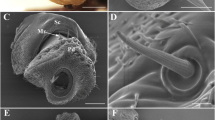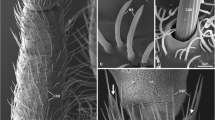Abstract
Blow fly, Triceratopyga calliphoroides Rohdendorf, is a common and synanthropic species of medical and forensic significance in eastern Asia. Field monitoring studies have indicated that olfaction system plays an important role in guiding the behavior of insect species. To further our understanding of fly olfaction, scanning electron microscopy (SEM) and laser scanning confocal microscopy (LSCM) are applied to examine the sensillar morphology of adults, with an emphasis on sensory pit and sacculus. Both microtrichiae and several mechanoreceptors are detected on antennal scape and pedicel. Except for these two structures, pedicellar buttons are also found in antennal pedicellar depression after the separation of antennal pedicel and funiculus. Eight types of antennal sensilla are observed on external surface of antennal funiculus (one type of trichoid sensilla, three types of basiconic sensilla, three types of coeloconic sensilla, and one type of clavate-like sensilla), while two types (one type of basiconic sensilla and one type of coeloconic-like sensilla) are detected at the inner surface of sensory pits or sacculus. As the first to investigate cuticular invaginations of blow flies via paraffin section, the internal structure of abundant sensory pits and an excessively complex sacculus on antennal funiculus are revealed. After comparison to other species previously studied, this phenomenon is proved to be the most unique feature of T. calliphoroides, armed with a discussion on its morphology, function, and possible evolutionary implications.






Similar content being viewed by others
References
Bruyne M, Foster K, Carlson JR (2001) Odor coding in the Drosophila antenna. Neuron 30:537–552
Chen HH, Zhao YX, Kang L (2003) Antennal sensilla of grasshoppers (Orthoptera: Acrididae) in relation to food preferences and habits. J Biosci 28:743–752
Cônsoli FL, Kitajima EW, Parra JRP (1999) Sensilla on the antenna and ovipositor of the parasitic wasps Trichogramma galloi Zucchi and T. pretiosum Riley (Hym., Trichogrammatidae). Microsc Res Tech 45:313–324
de Fernandes F, Bahia-Nascimento AC, Pinto LC, de Leal C, Secundino NFC, Pimenta PFP (2008) Fine structure and distribution pattern of antennal sensilla of Lutzomyia longipalpis (Diptera: Psychodidae) sand flies. J Med Entomol 45:982–990
Faucheux MJ (2006) Antennal sensilla of male Lophocorona pediasia Common 1973 and their phylogenetic implications (Lepidoptera: Lophocoronidae). Ann soc entomol Fr (ns) 42(1):113–118
Faucheux MJ, Gibernau M (2011) Antennal sensilla in five Psychodini moth flies (Diptera: Psychodidae: Psychodinae) pollinators of Arum spp. (Araceae). Ann soc entomol Fr (ns) 47:89–100
Gao ZR, Wang JF, Wan XB, Chen YC (2006) A summary of the distribution of sarcosaprophagous flies in China. Acta Parasitol Med Entomol Sin 13:251–256
Grassberger M, Reiter C (2001) Effect of temperature on Lucilia sericata (Diptera: Calliphoridae) development with special reference to the isomegalen- and isomorphen-diagram. Forensic Sc Int 120:32–36
Greenberg J (2004) A natural history of the Chicago region. University of Chicago, Chicago
Greenberg B, Kunich JC (2002) Entomology and the law: flies as forensic indicators. Cambridge University Press, Cambridge
Hallem EA, Dahanukar A, Carlson JR (2006) Insect odor and taste receptors. Annu Rev Entomol 51:113–135
Hunter FF, Adserballe CF (1996) Cuticular structures on the antennae of Hypoderma bovis De Geer (Diptera: Oestridae) females. Int J Insect Morphol Embryol 25:173–181
McAlpine JF (1981) Morphology and terminology—adults. In: McAlpine JF, Peterson BV, Shewell GE, Teskey HJ, Vockeroth JR, Wood DM (coords.) Manual of Nearctic Diptera, Vol. 1. Research Branch, Agriculture Canada Monograph, 27, pp 9–63
McAlpine DK (2011) Observation on antennal morphology in Diptera with particular reference to the articular surfaces between segments 2 and 3 in the Cyclorrhapha. Rec Aust Mus 63:113–166
Merivee E, Rahi M, Bresciani J, Ravn HP, Luik A (1998) Antennal sensilla of the click beetle, Limonius aeruginosus (Oliver) (Coleoptera: Elateridae). Int J Insect Morphol Embryol 16:200–207
Poddighe S, Dekker T, Scala A, Angioy AM (2010) Olfaction in the female sheep botfly. Naturwissenschaften 97:827–835
Romani R, Stacconi MVR, Riolo P, Isidoro N (2009) The sensory structures of the antennal flagellum in Hyalesthes obsoletus (Hemiptera: Fulgoromorpha: Cixiidae): a functional reduction? Arthropod Struct Dev 38:473–483
Rospars JP (1988) Structure and development of the insect antennodeutocerebral system. Int J Insect Morphol Embryol 17:243–294
Ross KTA (1992) Comparative study of the antennal sensilla of five species of root maggots: Delia radicum L., D. floralis F., D. Antique Mg., D. platura Mg. (Diptera: Anthomyiidae), and Psila rosae F. (Diptera: Psilidae). Int J Insect Morphol Embryol 21:175–197
Ross KTA, Anderson M (1991) Ultrastructure of the funicular sensilla of the cabbage root fly, Delia radicum L. (Diptera: Anthomyiidae). Int J Insect Morphol Embryol 20:83–101
Schneider D (1964) Insect antennae. Annu Rev Entomol 9:103–112
Setzu MD, Poddighe S, Angioy AM (2011) Sensilla on the antennal funiculus of the blow fly, Protophormia terraenovae (Diptera: Calliphoridae). Micron 42:471–477
Shanbhag SR, Singh K, Singh RN (1995) Fine structure and primary sensory projections of sensilla located in the sacculus of the antenna of Drosophila melanogaster. Cell Tissue Res 282:237–249
Shanbhag SR, Muller B, Steinbrecht RA (1999) Atlas of olfactory organs of Drosophila melanogaster 1. Types, external organization, innervation and distribution of olfactory sensilla. Int J Insect Morphol Embryol 28:377–397
Shanbhag SR, Muller B, Steinbrecht RA (2000) Atlas of olfactory organs of Drosophila melanogaster 2. Internal organization and cellular architecture of olfactory sensilla. Arthropod Struct Dev 29:211–229
Smallegange RC, Kelling RJ, Den Otter CJ (2008) Types and numbers of sensilla on antennae and maxillary palps of small and large houseflies, Musca domestica (Diptera, Muscidae). Microsc Res Tech 71:880–886
Smith KM (1919) Comparative study of certain sense-organs in the antennae and palpi of Diptera. Proc Zool Soc Lond 1919:31–69
Sukontason K, Sukontason KL, Piangjai S, Boonchu N, Chaiwong T, Ngern-klun R, Sripakdee D, Vogtsberger RC, Olson JK (2004) Antennal sensilla of some forensically important flies in families Calliphoridae, Sarcophagidae and Muscidae. Micron 35:671–679
Xue WQ, Chao JM (1996) Flies of China. Liaoning Science and Technology, Shenyang
Zhang D, Wang QK, Hu DF, Li K (2012) Sensilla on the antennal funiculus of the stomach bot fly, Gasterophilus nigricornis (Diptera: Oestridae). Med Vet Entomol 26:314–322
Zhang D, Wang QK, Yang YZ, Chen YO, Li K (2013) Sensory organs of the antenna of two medically and hygienically important Fannia species (Diptera: Fanniidae). Parasitol Res 112:2177–2185
Zhong HP, Wan XY, Lu SP, Wang FJ (2007) Investigation on vector organism at Changsha International Airport. Chin J Front Health Quarantine 30:83–89
Acknowledgments
We are grateful to Drs. Mei-Qin Liu and Jun-Na Shi (Beijing Forestry University), who gave us invaluable help with this study. This study was supported by the Program for New Century Excellent Talents in University (no. NCET-12-0783) and the National Science Foundation of China (no. 31201741).
Conflict of interests
The authors declare no conflict of interest.
Author information
Authors and Affiliations
Corresponding authors
Additional information
D. Zhang and X. H. Liu contributed equally to this work.
Rights and permissions
About this article
Cite this article
Zhang, D., Liu, X.H., Wang, Q.K. et al. Sensilla on the antenna of blow fly, Triceratopyga calliphoroides Rohdendorf (Diptera: Calliphoridae). Parasitol Res 113, 2577–2586 (2014). https://doi.org/10.1007/s00436-014-3909-6
Received:
Accepted:
Published:
Issue Date:
DOI: https://doi.org/10.1007/s00436-014-3909-6




